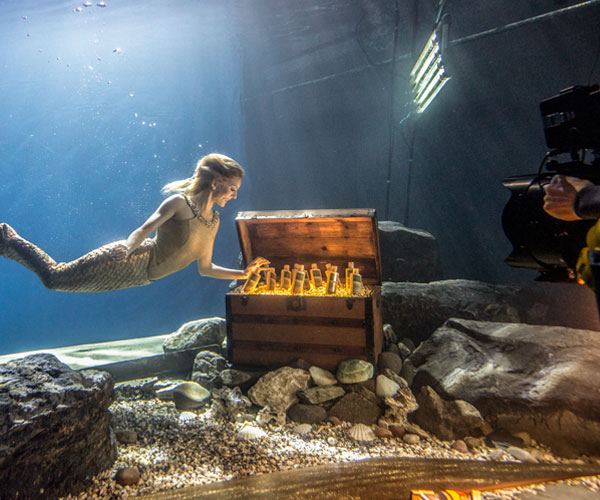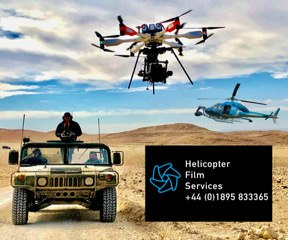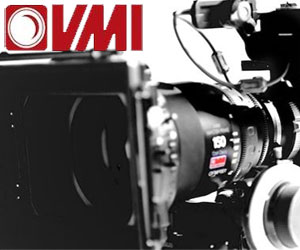Broadcast News
18/04/2018
How To Transform Your Production Using An Underwater Sequence

Having shot as an underwater stills specialist for over 20 years shooting ads, wildlife and editorial I thought it was time to move over to stills' more grown-up cousin underwater filming about three years ago.
Underwater stills is all about teamwork, requiring a massive effort from the whole shoot production team. Nevertheless most of the pre production and a good degree of the post production lands on one's own desk and the photographer tends to wear many hats in the process. However the very definition of film production is a genuine team effort all round. Adapting to that fact is essential and following on from there is a matter of transferring a lot of one's skills over as quickly as possible and learning new ones from one's heros or mentors.
An underwater film sequence can change the fabric of a production subtly if the script allows for this. If relevant to the storyline it can describe, in a very visual way, the script's narrative, emphasizing the emotions and action the director needs and adding extra visual choices to the story line.
Judicious use of lighting and camera technique can make a shot come to life, creating anything from a murky riverbed, pool scene or even a seascape to suit.
Lighting is super important and a lighting gaffer who is experienced with water is essential. Lighting choices and principles are similar with the underwater set as in a dry one, with the addition of the extra safety required from an experienced lighting team.
Depending on the director's vision we tend to use lighting to replicate natural light or a sun substitute with fill and bounce, utilising lighting as diverse as HMIs, tungsten and underwater Kinoflows for fill so it looks as realistic as possible. But anything is possible with a good lighting gaffer.
Filming tanks can vary in scale and budget from portable tanks transported to a production car park, a bespoke film tank with a large body of clean warm water with wide gantries for lighting, or a location shoot in the sea or a murky river bed. I have shot in all of these places and the diversity makes it interesting.
Most good cinematic movie cameras can be housed in professional waterproof housings and give the underwater camera operator/director the same choices he or she has topside. Indeed no real camera setting choices have to be made in air once the camera operator is underwater as most or all the controls are accessible underwater. Camera controls can indeed be handed over to a topside team and taken away altogether from the underwater camera operator, taking control of focus, iris, and zoom controls as required, allowing a good camera operator free to simply compose the shot. All images, piped to the surface via a long RT motion cable to a video village and directions, are routinely given via underwater communication systems or a hydrophone.
All the above is wrapped up in good diving practices and a solid dive safety team, all HSE compliant. These are the people who stay the longest on the production and look after the artists in the water. If an artist is required, usually a three man safety dive team is needed to look after them keeping them safe and feeding them air when required. With this in mind some form of training is normally required even if it is just a day acclimatisation to working in and underwater.
Underwater filming is an extra string to a production's bow and, where appropriate, worth seriously considering.
By Zac Macaulay
www.zacmacaulay.com
Underwater stills is all about teamwork, requiring a massive effort from the whole shoot production team. Nevertheless most of the pre production and a good degree of the post production lands on one's own desk and the photographer tends to wear many hats in the process. However the very definition of film production is a genuine team effort all round. Adapting to that fact is essential and following on from there is a matter of transferring a lot of one's skills over as quickly as possible and learning new ones from one's heros or mentors.
An underwater film sequence can change the fabric of a production subtly if the script allows for this. If relevant to the storyline it can describe, in a very visual way, the script's narrative, emphasizing the emotions and action the director needs and adding extra visual choices to the story line.
Judicious use of lighting and camera technique can make a shot come to life, creating anything from a murky riverbed, pool scene or even a seascape to suit.
Lighting is super important and a lighting gaffer who is experienced with water is essential. Lighting choices and principles are similar with the underwater set as in a dry one, with the addition of the extra safety required from an experienced lighting team.
Depending on the director's vision we tend to use lighting to replicate natural light or a sun substitute with fill and bounce, utilising lighting as diverse as HMIs, tungsten and underwater Kinoflows for fill so it looks as realistic as possible. But anything is possible with a good lighting gaffer.
Filming tanks can vary in scale and budget from portable tanks transported to a production car park, a bespoke film tank with a large body of clean warm water with wide gantries for lighting, or a location shoot in the sea or a murky river bed. I have shot in all of these places and the diversity makes it interesting.
Most good cinematic movie cameras can be housed in professional waterproof housings and give the underwater camera operator/director the same choices he or she has topside. Indeed no real camera setting choices have to be made in air once the camera operator is underwater as most or all the controls are accessible underwater. Camera controls can indeed be handed over to a topside team and taken away altogether from the underwater camera operator, taking control of focus, iris, and zoom controls as required, allowing a good camera operator free to simply compose the shot. All images, piped to the surface via a long RT motion cable to a video village and directions, are routinely given via underwater communication systems or a hydrophone.
All the above is wrapped up in good diving practices and a solid dive safety team, all HSE compliant. These are the people who stay the longest on the production and look after the artists in the water. If an artist is required, usually a three man safety dive team is needed to look after them keeping them safe and feeding them air when required. With this in mind some form of training is normally required even if it is just a day acclimatisation to working in and underwater.
Underwater filming is an extra string to a production's bow and, where appropriate, worth seriously considering.
By Zac Macaulay
www.zacmacaulay.com
More Corporate Video Production Stories
21/01/2019
BP Invests In XStream EFS Scale-Out Storage Platform
EditShare has announced that global energy brand BP, has invested in the XStream EFS scale-out storage platform and Flow media asset management to man
BP Invests In XStream EFS Scale-Out Storage Platform
EditShare has announced that global energy brand BP, has invested in the XStream EFS scale-out storage platform and Flow media asset management to man
17/05/2018
LinkedIn B2B Video Marketing Tactics For 2018
LinkedIn should be a hotbed for B2B video marketing in 2018, but many companies are neglecting this opportunity. If you look at your profile feed, you
LinkedIn B2B Video Marketing Tactics For 2018
LinkedIn should be a hotbed for B2B video marketing in 2018, but many companies are neglecting this opportunity. If you look at your profile feed, you
18/04/2018
How To Transform Your Production Using An Underwater Sequence
Having shot as an underwater stills specialist for over 20 years shooting ads, wildlife and editorial I thought it was time to move over to stills' mo
How To Transform Your Production Using An Underwater Sequence
Having shot as an underwater stills specialist for over 20 years shooting ads, wildlife and editorial I thought it was time to move over to stills' mo
30/11/2017
The Corporate Video – Great Telly Not On TV
Liam Creagh runs Belfast television and video production company Red Box Media. His company produces television programmes but discovered early on tha
The Corporate Video – Great Telly Not On TV
Liam Creagh runs Belfast television and video production company Red Box Media. His company produces television programmes but discovered early on tha
23/10/2017
Testimonial Videos And Why They Work
In this guest article for 4rfv.co.uk, Ian Palmer of The Marketing Café, explores the power of putting your clients or customers on camera in a video t
Testimonial Videos And Why They Work
In this guest article for 4rfv.co.uk, Ian Palmer of The Marketing Café, explores the power of putting your clients or customers on camera in a video t
02/06/2017
How To Get Return Of Investment From Video
So you've been thinking about making a video, or you already have jumped in head first and gone and made one. Well we salute you, you savvy, forward t
How To Get Return Of Investment From Video
So you've been thinking about making a video, or you already have jumped in head first and gone and made one. Well we salute you, you savvy, forward t
26/04/2017
Digifish: On Video Content On Facebook
In 2017, Facebook is no longer an option when it comes to our marketing strategies. According to Hubspot, a whopping 2 billion people use Facebook. No
Digifish: On Video Content On Facebook
In 2017, Facebook is no longer an option when it comes to our marketing strategies. According to Hubspot, a whopping 2 billion people use Facebook. No
05/04/2017
How To Convince Your Boss That Video Needs To Be Part Of Your Marketing Strategy
We've all been there – we have an idea that we know will benefit the business we work for, but we don’t feel we are being listened to or taken serious
How To Convince Your Boss That Video Needs To Be Part Of Your Marketing Strategy
We've all been there – we have an idea that we know will benefit the business we work for, but we don’t feel we are being listened to or taken serious
08/11/2016
Using Video To Build Your Brand
So, your organisation is exceptional, with great products and customer service but does your marketing reflect your true value, asks Minamonfilm. The
Using Video To Build Your Brand
So, your organisation is exceptional, with great products and customer service but does your marketing reflect your true value, asks Minamonfilm. The
13/06/2016
A Guide To Commissioning A Corporate Video Production
This is a guide to speaking the language of corporate video production companies in order to describe your project, find out what options are availabl
A Guide To Commissioning A Corporate Video Production
This is a guide to speaking the language of corporate video production companies in order to describe your project, find out what options are availabl















